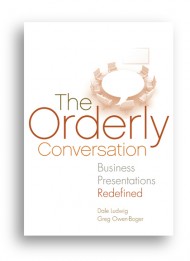
Review originally posted at The San Francisco Book Review


The Orderly Conversation depends on an assumption that business presentations are inherently different from other forms of public speaking, and so to be truly successful, presenters must learn a whole new set of skills. I’m not entirely sure that I agree with this assumption, since the authors seem to indicate that the main difference is that a business presentation requires an understanding of and connection with the audience. I would argue that audience connection is also vital to speech-making, as well as written communication (which is shown in this book as the “orderly” side of the order/conversation continuum). The thing that makes business presentations so different is the raised stakes—a failed business presentation can mean no sales, loss of a client, being passed over for needed funding, important instructions not being understood or followed, really the failure to accomplish the goal behind the presentation.
Now, the fact that I disagree with one of the major assumptions in the book does not mean that I think the book is without merit. Far to the contrary, I feel that the advice given here can be useful far beyond the somewhat limited scope of the business presentation (although there is plenty of variety included in that heading). Every speaker, whether in business, politics, or classroom, should learn their own natural inclinations when speaking, when those natural inclinations help and hinder, and specific ways to improve. Every speaker, regardless of setting, needs to know how to prepare effectively to allow for both the planned message and flexibility to adapt the plan. Every speaker should focus on meeting the needs of their audience, and should be armed with techniques to recognize if those needs are not being met in the presentation, and ways to remedy the situation.
Throughout the book, Dale Ludwig presents new information, while Greg Owen-Boger gives us practical application with example studies of a fictional workshop group (fictional characters that are composites of real people with real struggles that they have worked with). The eight people in the group each have different presentation styles, each have different reasons for participating in the workshop, and each have different needs and goals. This method of presenting the information was fantastic because you can clearly see how the advice given in the book can be adjusted to a variety of situations. At first I thought it would be difficult to keep track of so many different people, but each was a fully developed character with backstory and there never was any confusion between them. They are even represented by eight distinctive handwriting samples to keep a visual difference.
In addition to offering very useful advice and strategies for giving successful presentations, this book is just really well crafted. As mentioned before, there are visual cues for each of the workshop participants, but there is also a visual distinction between Dale’s informational sections and Greg’s practical application. The format of the book follows the advice given to presenters—it is clear, concise, and every aspect is designed to meet the needs of the audience. It frames the content with specific information in the introduction and conclusion, and even incorporates repeated internal framing visuals: the Table of Contents is repeated before each chapter—a reminder of what you’ve learned and where you’re going. Part of me wanted to think it was a waste of paper, part wondered why they would make such an unusual formatting decision, but by the time I reached the chapter where the technique was explained, I’d already decided it was more effective than wasteful.
The careful explanations and examples along with the minute considerations in formatting and design make this an instructional guidebook that practices what it preaches, and one that I can enthusiastically recommend.
Reviewed by Randy-Lynne Wach
 The Orderly Conversation is available as a paperback and ebook at these online stores.
The Orderly Conversation is available as a paperback and ebook at these online stores. 






